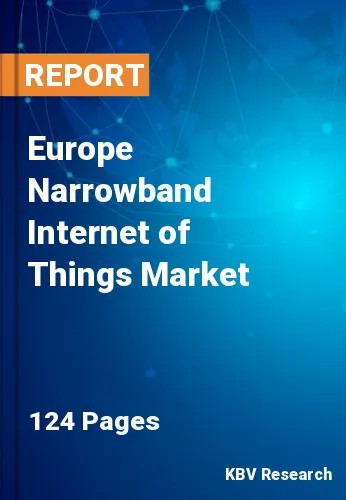
The Europe Narrowband Internet of Things Market would witness market growth of 51.2% CAGR during the forecast period (2022-2028).
Narrowband IoT is not created to substitute conventional 4G LTE range and different mobile networks. Instead, it is developed to operate beside them – offering inexpensive and reliable performance for low-powered IoT devices. Using NB-IoT would make the using IoT easier for commercial companies, industrial firms, and other consumers.
Providing LPWA connectivity via using authorized spectrum, mobile IoT technologies are propelling a significant growth of the IoT (Internet of Things) worldwide. These adaptable technologies are being developed to connect everything from digital locks and asset trackers to sensors monitoring the environment and smart meters. Standardized by 3GPP, the two-prime mobile IoT technologies – NB-IoT and LTE-M – are assisted by large number of equipment suppliers and mobile operators, allowing the ecosystem to get benefits from economies of low production range and deployment charges.
With the 2020 Smart City Model Projects Program in which 32 projects are funded with almost EUR 350 million, the German government is supporting the development of smart cities across the nation. Cities in Europe and Germany have expanded over time, digital technologies are being introduced, and enhancing existing infrastructures could be a long-time procedure.
Several German cities have evolved their smart city concepts under a single roof. By implementing initiatives like WiFi coverage throughout the entire city and intelligent parking systems, these are some of the UK cities that are setting the pace for the smart city revolution. The development of smart cities is propelling the growth of the NB-IoT market throughout the predicted period.
The Germany market dominated the Europe Narrowband Internet of Things Market by Country in 2021, and would continue to be a dominant market till 2028; thereby, achieving a market value of $661.2 million by 2028. The UK market is showcasing a CAGR of 49.9% during (2022 - 2028). Additionally, The France market would experience a CAGR of 52.3% during (2022 - 2028).
Based on Component, the market is segmented into Solution and Services. Based on Application, the market is segmented into Alarms & Detectors, Smart Meters, Trackers, Wearable Devices, Smart Parking, Smart Lighting, and Others. Based on Deployment Mode, the market is segmented into Guard, Stand-alone, and In-band. Based on Vertical, the market is segmented into Infrastructure, Energy & Utilities, Automotive & Transportation, Agriculture, Healthcare, Consumer Electronics, Manufacturing, and Others. Based on countries, the market is segmented into Germany, UK, France, Russia, Spain, Italy, and Rest of Europe.
Free Valuable Insights: The Global Narrowband Internet of Things Market will Hit $9.6 Billion by 2028, at a CAGR of 51.5%
The market research report covers the analysis of key stake holders of the market. Key companies profiled in the report include Intel Corporation, Qualcomm, Inc., Huawei Technologies Co., Ltd. MediaTek, Inc., Nokia Corporation, Verizon Communications, Inc., AT&T, Inc., Vodafone Group Plc, Orange S.A., and Ericsson AB.
By Component
By Application
By Deployment Mode
By Vertical
By Country
Our team of dedicated experts can provide you with attractive expansion opportunities for your business.
